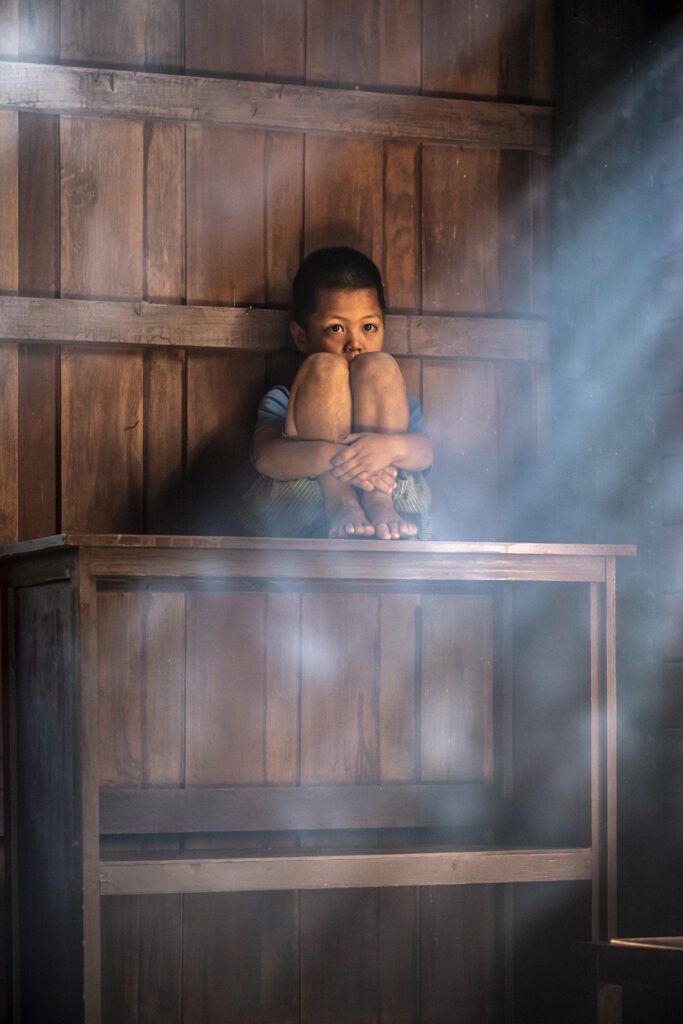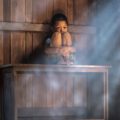The Four Fs: Fight, flight, freeze and fawn
As we learn more complex reactions to others during childhood and adolescence, and as children, we have no way of understanding abuse of any kind, it is no surprise that infants and children show trauma reactions which we share with our animal ancestors: the Four Fs.
With animals, a threat first causes heightened awareness, checking for further information about the threat, and eventually resulting in the immediate freeze, fight or flight. In the case of threats from other animals, it is mostly about visual cues, sounds, and body language betraying the intentions of the other animal. Complex neural wiring then allows reacting in four different ways. A more complete and accurate description of this instinct is the fight/flight/freeze/fawn response. The latter is a typical reaction of pack or herd animals. Therefore, the Four Fs are an innate, automatic response triggered by any perceived danger, animals and humans alike.
A fight response is an aggressive reaction; flight means fleeing from danger or, symbolically, launching into hyperactivity. A freeze response is triggered when resistance seems futile and results in giving up, numbing out or other forms of dissociation, accepting the inevitability of being hurt. Finally, the fawn response uses appeasement to avoid attacks or abandonment. These four types of childhood trauma reactions are hence referred to as the Four Fs.
By the way, the Four F actions also have a polarity – the individual can either fight against or flee from a threat or fight for or fly towards something that is needed, such as the saving bank of a raging river. Other animals have different self-protection methods, such as changing colour to camouflage themselves to escape capture, either in a physical or sensory way. Thus, flight can mean disappearing to another location or just disappearing in place, and fight and flight are often combined in a given situation.
The Four Fs are also summed up as hyperarousal or acute stress reaction. They require a general sympathetic nervous system discharge to prepare the described actions. The source of this discharge are small, triangular-shaped glands located on top of both kidneys – the suprarenal glands. They help regulate our metabolism, immune system, blood pressure, response to stress and other essential functions. In case of a threat, they release a cascade of hormones, including the stress signals norepinephrine and epinephrine, but also estrogen, testosterone, and cortisol, as well as the neurotransmitters dopamine and serotonin, which all affect how organisms react to stress.
The Four Fs – how they develop
In the face of trauma, children automatically react with one of these inborn reactions to survive, and as time passes, the Four Fs gravitate towards a more or less stable pattern, including more elaborate ego defences such as narcissism (fight), obsessive/compulsive behaviours (flight), dissociation (freeze) or codependence (fawn). While helping children survive their emotional torment, they leave their responses to life and attachment to others very rigid and narrow even in adulthood, when they no longer need to rely on such primary reaction patterns. The pattern arising in each trauma survivor depends upon the actual experience of abuse as much as upon birth order and even innate temperamental predispositions. The Four F pattern is specific for each individual.
The Four Fs – Flight
Scapegoating is a form of bullying that displaces emotional pain, stress, and frustration upon a weaker person. Scapegoating yields some relief, but as it leaves a bully’s pain unchanged, scapegoating soon resumes when the bully’s distress resurfaces. Parental or sibling scapegoating takes many forms, including even manipulating an entire dysfunctional family to gang up against the scapegoat. The victim of scapegoating feels humiliated and overwhelmed. It has neither power to protest nor the ability to comprehend the unfairness of the abuse and eventually becomes convinced that she is the cause of the abuse by being defective and fatally flawed. Children even become convinced that they deserve no better than persecution. Early disdainfully blaming a child for soiling her diaper before she is even one, punishing her for making noise, and being spontaneous, playful and joyous, produces a permanent anxiety-driven arousal level bordering ADHD. Unfortunately, even after escaping their toxic family, such children may remain symbolically chained to the abuse by becoming entrapped by narcissistic people who turn out to be just as abusive and neglectful as their parents. This psychological phenomenon, frequent among trauma survivors, is called repetition compulsion or re-enactment.
The Four Fs – Fight
Talking about narcissists, a child recipient of a parent’s narcissistic expectations will be turned into an over-achiever to avoid the withdrawal of parental approval for less-than-perfect performances. The contrast between titbits of praise for outstanding accomplishments reflecting positively on the parents and rejection or withdrawal of affection for anything less makes such a child susceptible to perfectionism and a narcissist’s ability to identify others as scapegoats to displace their own emotional pain. Hurting from parents thus creates a narcissist “control freak” who is always ready to aggressively mould their romantic partner exactly the way they have been moulded.
The Four Fs – Freeze
If a child is subjected to neglect rather than dysfunctional parental attention, they may turn into a classic “lost child” left to raise herself. Food and daydreaming are becoming the first sources of comfort for such children, while staying in their own little world as much as possible. Finally, they may numb out into a paralysing dissociative depression, with extreme anxiety and avoidant apprehension in front of any social situation. Add television to the disaster, and you have the recipe for an attachment disorder that bonds with TV more than with human beings. Numbing substances, eating disorders or hoarding may become expressions of the underlying anxieties when such children turn into adults.
The Four Fs – Fawn
When neglect hits a sensitive child gifted with compassion, they may find out that studying the abusive parent enough, figuring out their needs and providing for them may lead to calming the abuser down and make him less dangerous or toxic or even gain one little bit of their attention merely. Such children learn to hone their skills and to almost clairvoyantly anticipate their abuser’s sore spots, moods and preferences, fulfilling them even before the abusive parent knows about their desires in their attempt to defuse anger and fish for morsels of approval. In this toxic interplay, the abusive parent turns the child into the “narcissistic extension” of his own neediness, exploiting their readiness to please and good-humoured nature by putting them in the place of a servant in the household. This enmeshment may lead to the child’s misplaced loyalty towards the abusive parent long into adulthood, creating enmeshment in the form of codependent slavery.
As stated above, the individual pattern of the Four Fs is responsible for the various types of cPTSD. They may lead to many other, more or less, dysfunctional coping strategies later in life. Whatever their scope and directions, all Four Fs have in common a fear that is horrible for mammal infants: the fear of abandonment. When that occurs, abandonment depression sets in, the “black night of the soul”. So, the primordial defence mechanisms are all intended to fight off the abandonment depression and will, therefore, be further analysed in other posts.
Yet, abandonment depression can be managed. The first step needed is to acknowledge the challenge, and identify feelings and how they affect you and why. Likewise, learning how the feeling manifests itself with you is important. The second step thus would be to know your emotional and physical symptoms. The third step is to seek help to overcome the toxic self-image, dysfunctional reactions to others and rigid attachment patterns that came to your attention. And always remember: a cPTSD is not some form of madness or handicap, but a normal reaction to a deeply abnormal situation.
Source:
Pete Walker: Complex PTSD: From Surviving to Thriving: A Guide and Map for Recovering From Childhood Trauma





